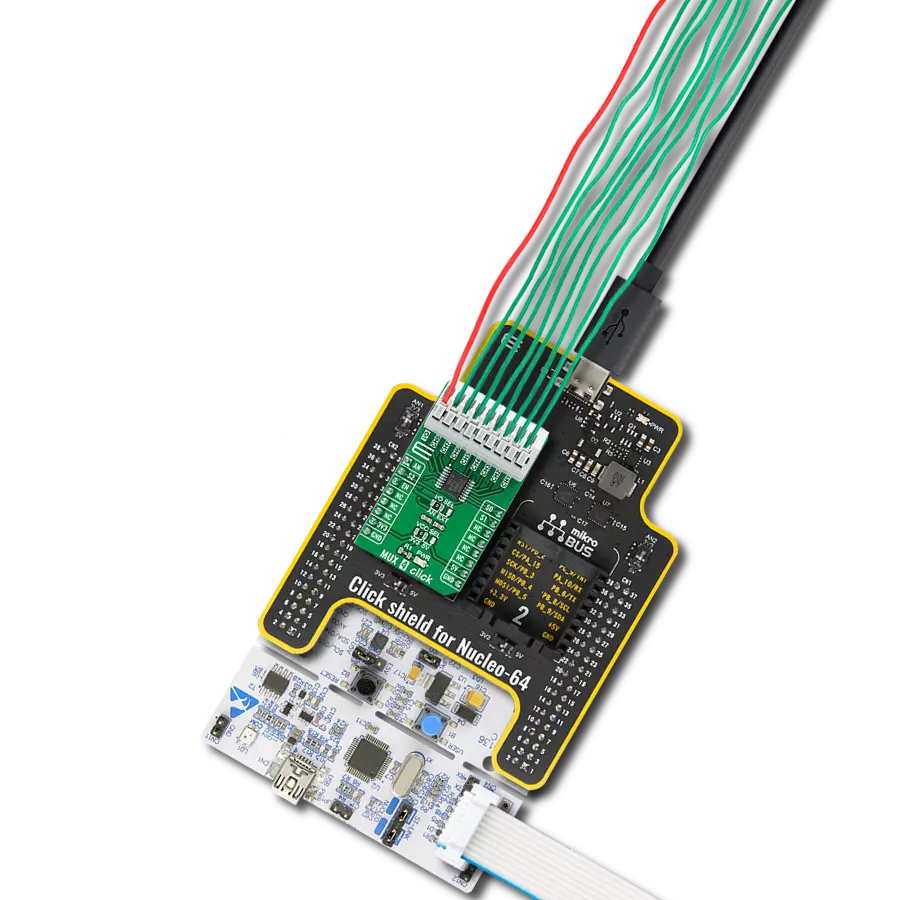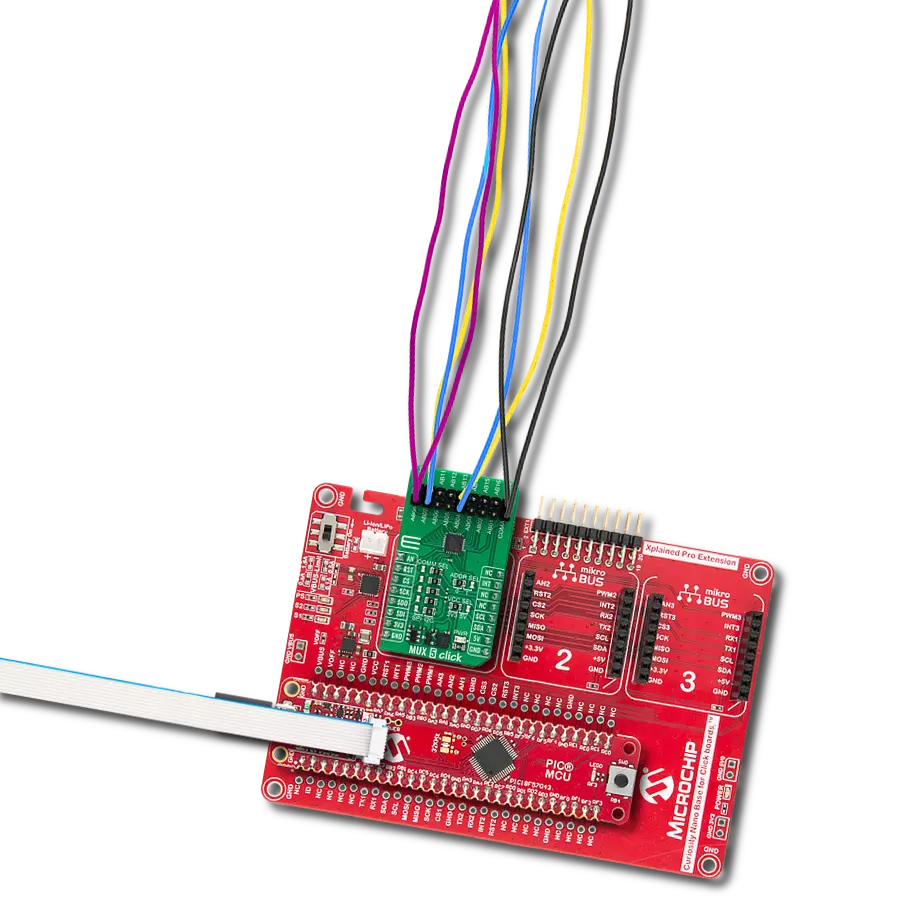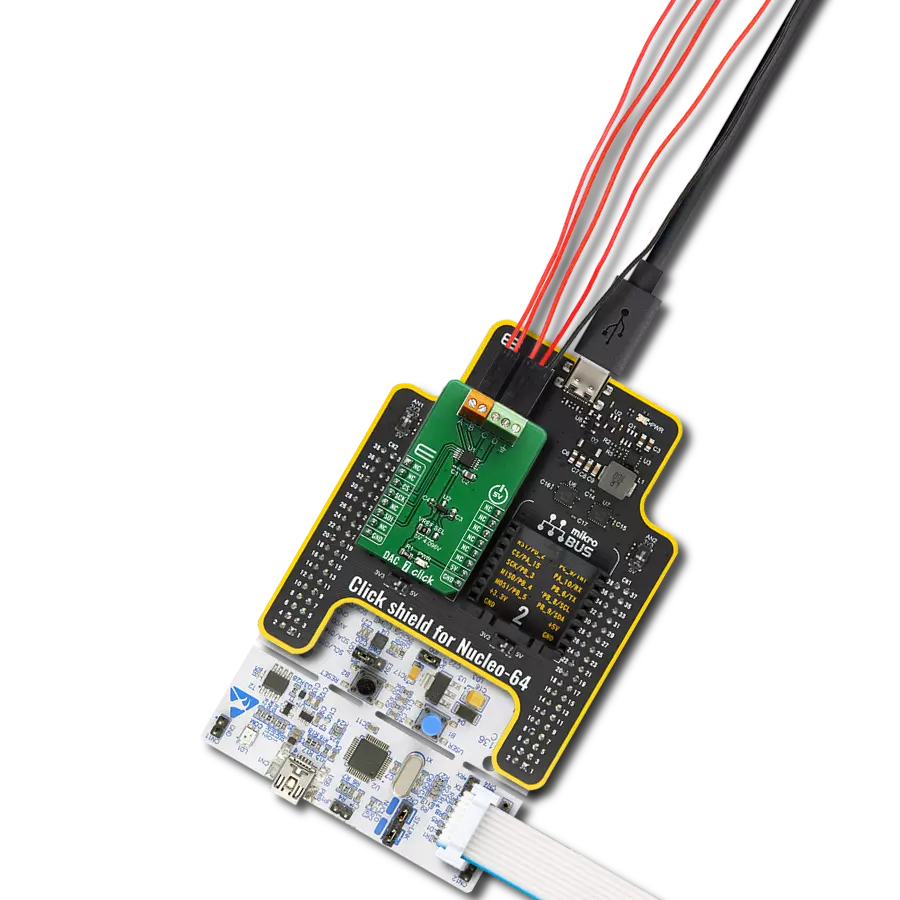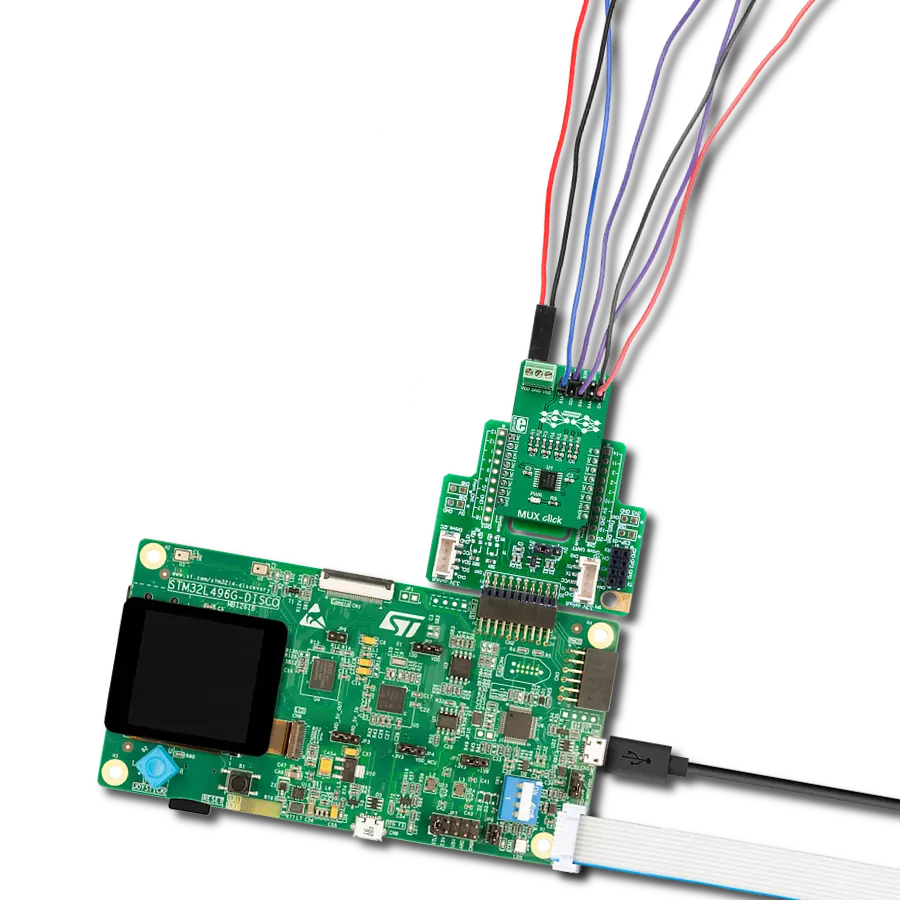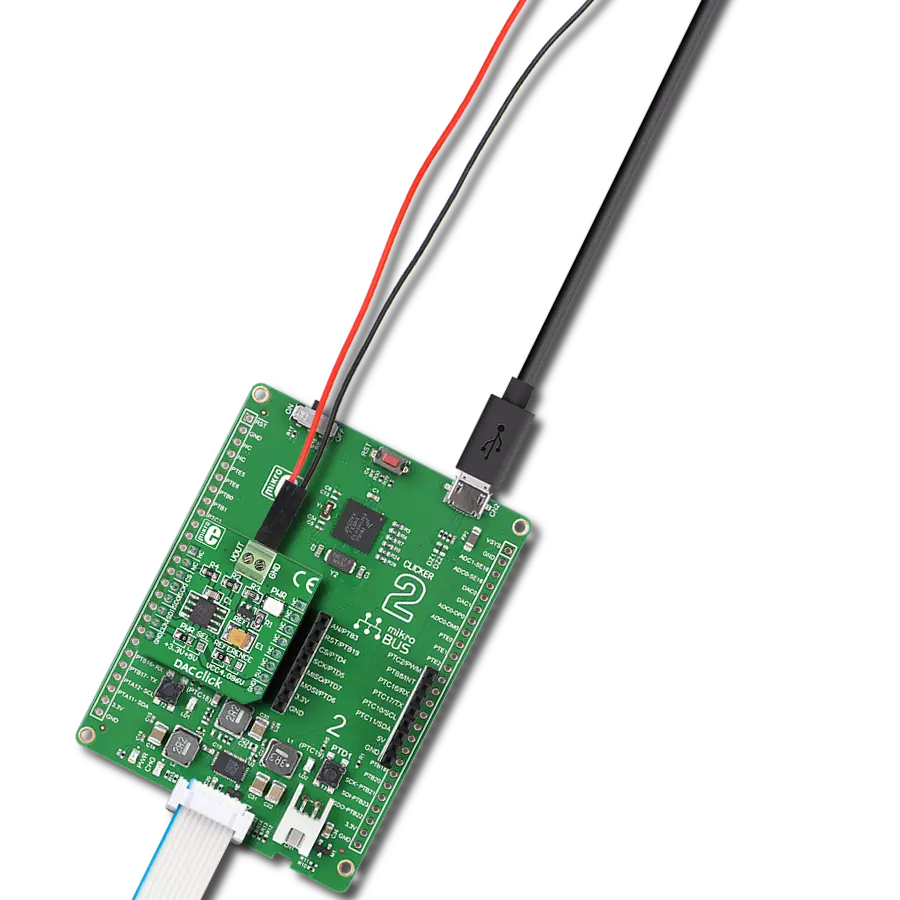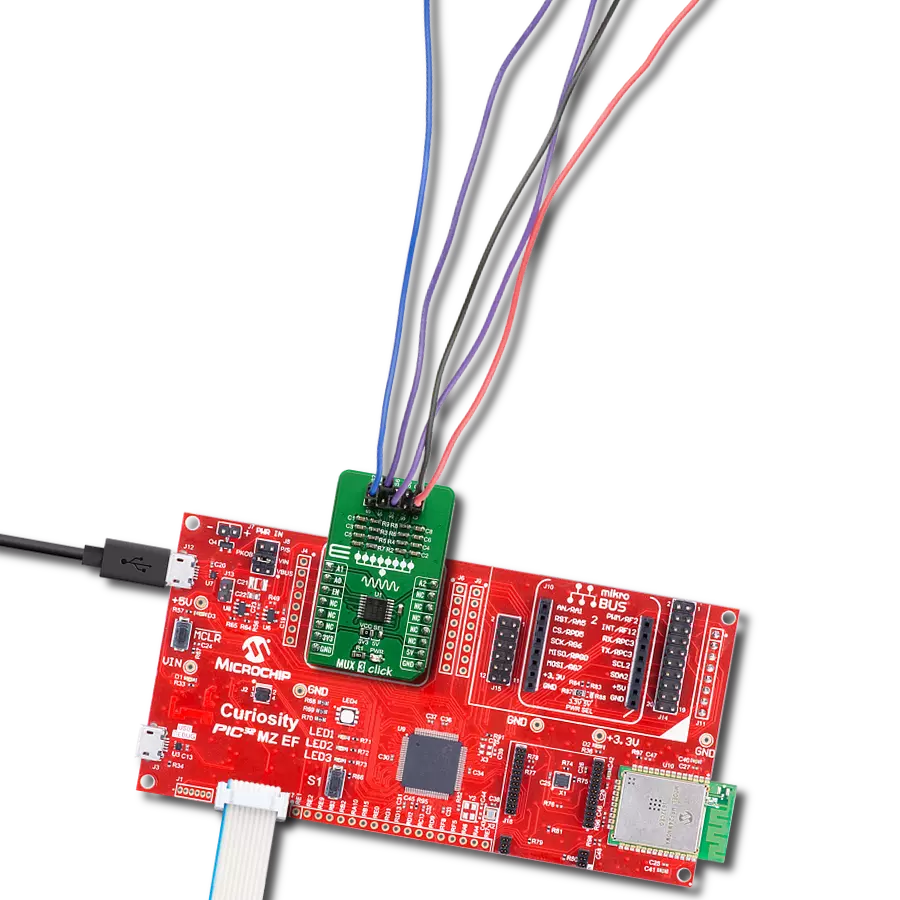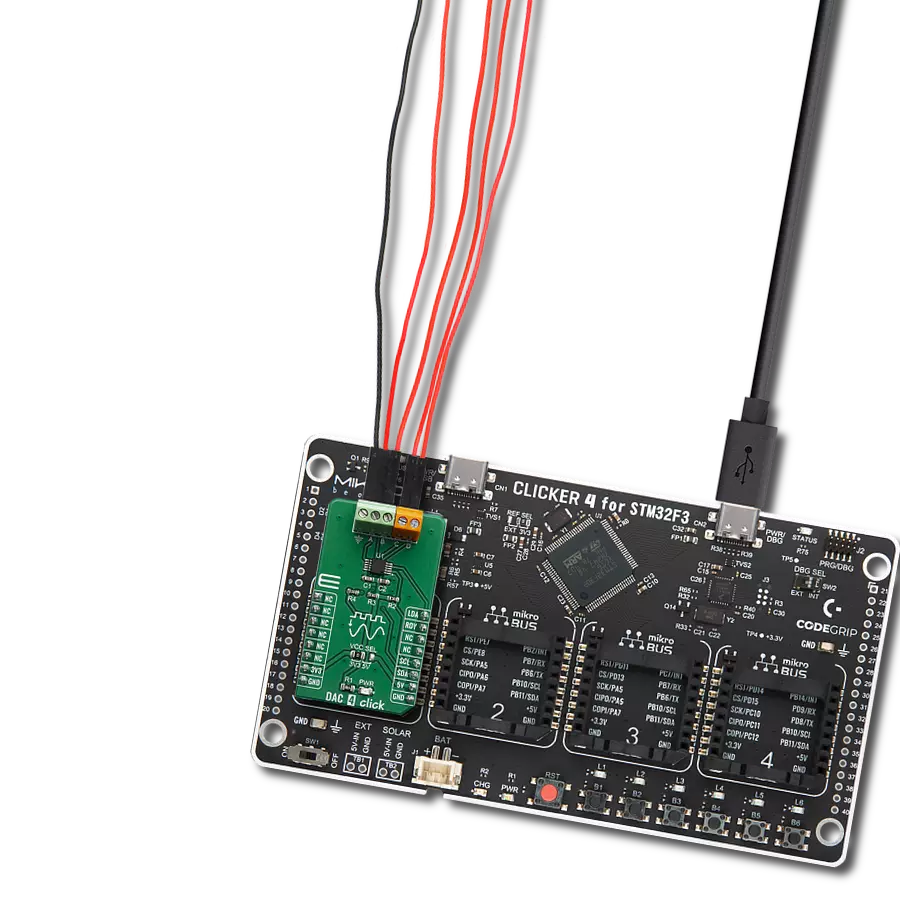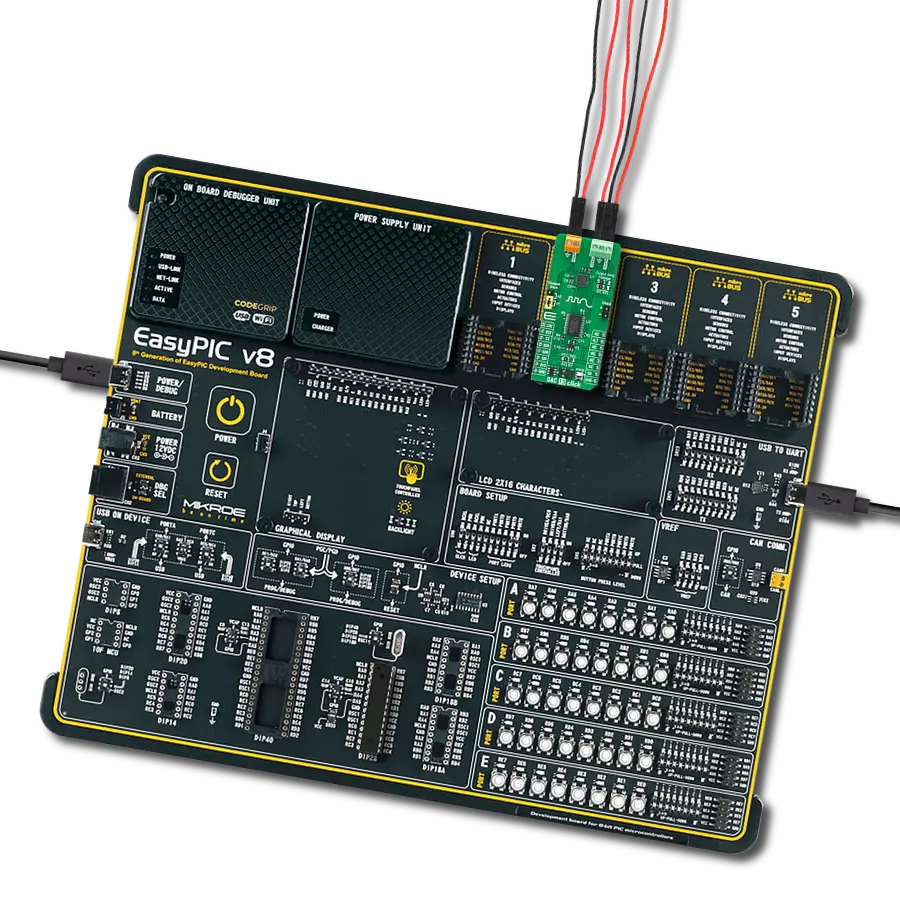Excellent choice for applications such as voltage margining and scaling, DC set-point for biasing and calibration, and waveform generation
A
A
Hardware Overview
How does it work?
DAC 16 Click is based on the DAC63204-Q1, a highly reliable, automotive-qualified, quad-channel, buffered digital-to-analog converter (DAC) from Texas Instruments. This 12-bit DAC is versatile, providing both voltage and current outputs, making it ideal for various applications such as voltage margining and scaling, DC set-point biasing and calibration, and waveform generation. One of its key features is the Hi-Z power-down mode, which ensures that the outputs maintain a high-impedance state during power-off conditions, offering additional protection and minimizing power consumption. The DAC63204-Q1 supports flexible configuration of its output channels (OUT0-OUT3). For voltage outputs, it provides a 1LSB differential non-linearity (DNL) and allows for adjustable gains, with options of 1x, 1.5x, 2x, 3x, and 4x. For current outputs, it offers a range of ±25μA to ±250μA, with 1LSB integral non-linearity (INL) and DNL (8-bit),
making it suitable for precision applications requiring fine control over current delivery. This DAC can operate using either an internal reference, an external reference (selectable via an unpopulated VREF EXT header), or the power supply itself as the reference. The full-scale output can range from 1.8V to 5V, depending on the reference source. Selection between the internal and external voltage reference is easily managed by positioning the VREF SEL jumper to either the INT or EXT position. Communication with the host MCU is made through either a 4-wire SPI or I2C interface. The SPI interface supports clock frequencies up to 50MHz, while the I2C interface operates up to 1MHz. The desired communication protocol can be selected via the four COMM SEL jumpers, with the I2C interface being set as the default. Additionally, the I2C interface allows for flexible address configuration using the ADDR SEL
jumper, offering four selectable I2C addresses (with 0x48 set by default). Beyond communication, DAC 16 Click also provides a general-purpose I/O (GP) pin, which is highly configurable for various functions, such as serving as an SDO pin, LDAC, power-down (PD), status indicator, protection, fault dump, or reset. The specific function of the GP pin can be configured through the register map and programmed into non-volatile memory (NVM) for persistent settings. This Click board™ can operate with either 3.3V or 5V logic voltage levels selected via the VCC SEL jumper. This way, both 3.3V and 5V capable MCUs can use the communication lines properly. Also, this Click board™ comes equipped with a library containing easy-to-use functions and an example code that can be used as a reference for further development.
Features overview
Development board
Nucleo-64 with STM32F446RE MCU offers a cost-effective and adaptable platform for developers to explore new ideas and prototype their designs. This board harnesses the versatility of the STM32 microcontroller, enabling users to select the optimal balance of performance and power consumption for their projects. It accommodates the STM32 microcontroller in the LQFP64 package and includes essential components such as a user LED, which doubles as an ARDUINO® signal, alongside user and reset push-buttons, and a 32.768kHz crystal oscillator for precise timing operations. Designed with expansion and flexibility in mind, the Nucleo-64 board features an ARDUINO® Uno V3 expansion connector and ST morpho extension pin
headers, granting complete access to the STM32's I/Os for comprehensive project integration. Power supply options are adaptable, supporting ST-LINK USB VBUS or external power sources, ensuring adaptability in various development environments. The board also has an on-board ST-LINK debugger/programmer with USB re-enumeration capability, simplifying the programming and debugging process. Moreover, the board is designed to simplify advanced development with its external SMPS for efficient Vcore logic supply, support for USB Device full speed or USB SNK/UFP full speed, and built-in cryptographic features, enhancing both the power efficiency and security of projects. Additional connectivity is
provided through dedicated connectors for external SMPS experimentation, a USB connector for the ST-LINK, and a MIPI® debug connector, expanding the possibilities for hardware interfacing and experimentation. Developers will find extensive support through comprehensive free software libraries and examples, courtesy of the STM32Cube MCU Package. This, combined with compatibility with a wide array of Integrated Development Environments (IDEs), including IAR Embedded Workbench®, MDK-ARM, and STM32CubeIDE, ensures a smooth and efficient development experience, allowing users to fully leverage the capabilities of the Nucleo-64 board in their projects.
Microcontroller Overview
MCU Card / MCU
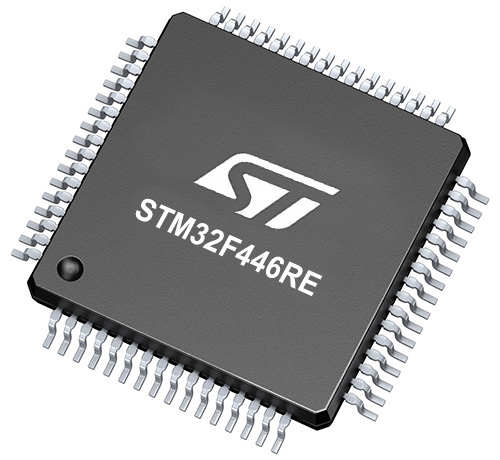
Architecture
ARM Cortex-M4
MCU Memory (KB)
512
Silicon Vendor
STMicroelectronics
Pin count
64
RAM (Bytes)
131072
You complete me!
Accessories
Click Shield for Nucleo-64 comes equipped with two proprietary mikroBUS™ sockets, allowing all the Click board™ devices to be interfaced with the STM32 Nucleo-64 board with no effort. This way, Mikroe allows its users to add any functionality from our ever-growing range of Click boards™, such as WiFi, GSM, GPS, Bluetooth, ZigBee, environmental sensors, LEDs, speech recognition, motor control, movement sensors, and many more. More than 1537 Click boards™, which can be stacked and integrated, are at your disposal. The STM32 Nucleo-64 boards are based on the microcontrollers in 64-pin packages, a 32-bit MCU with an ARM Cortex M4 processor operating at 84MHz, 512Kb Flash, and 96KB SRAM, divided into two regions where the top section represents the ST-Link/V2 debugger and programmer while the bottom section of the board is an actual development board. These boards are controlled and powered conveniently through a USB connection to program and efficiently debug the Nucleo-64 board out of the box, with an additional USB cable connected to the USB mini port on the board. Most of the STM32 microcontroller pins are brought to the IO pins on the left and right edge of the board, which are then connected to two existing mikroBUS™ sockets. This Click Shield also has several switches that perform functions such as selecting the logic levels of analog signals on mikroBUS™ sockets and selecting logic voltage levels of the mikroBUS™ sockets themselves. Besides, the user is offered the possibility of using any Click board™ with the help of existing bidirectional level-shifting voltage translators, regardless of whether the Click board™ operates at a 3.3V or 5V logic voltage level. Once you connect the STM32 Nucleo-64 board with our Click Shield for Nucleo-64, you can access hundreds of Click boards™, working with 3.3V or 5V logic voltage levels.
Used MCU Pins
mikroBUS™ mapper
Take a closer look
Click board™ Schematic

Step by step
Project assembly
Software Support
Library Description
This library contains API for DAC 16 Click driver.
Key functions:
dac16_set_dac_data- This function sets the raw DAC data for the selected DAC channel.dac16_start_function_gen- This function starts the function generator for the selected DAC channel.dac16_stop_function_gen- This function stops the function generator for the selected DAC channel.
Open Source
Code example
The complete application code and a ready-to-use project are available through the NECTO Studio Package Manager for direct installation in the NECTO Studio. The application code can also be found on the MIKROE GitHub account.
/*!
* @file main.c
* @brief DAC 16 Click example
*
* # Description
* This example demonstrates the use of DAC 16 Click board by changing the voltage level
* on the OUT0 as well as the waveform signals from a function generator on the OUT1.
*
* The demo application is composed of two sections :
*
* ## Application Init
* Initializes the driver and performs the Click default configuration.
*
* ## Application Task
* Changes the voltage level on the OUT0 as well as the waveform signals from a function
* generator on the OUT1 every 3 seconds. The state of all outputs will be displayed
* on the USB UART.
*
* @author Stefan Filipovic
*
*/
#include "board.h"
#include "log.h"
#include "dac16.h"
static dac16_t dac16;
static log_t logger;
void application_init ( void )
{
log_cfg_t log_cfg; /**< Logger config object. */
dac16_cfg_t dac16_cfg; /**< Click config object. */
/**
* Logger initialization.
* Default baud rate: 115200
* Default log level: LOG_LEVEL_DEBUG
* @note If USB_UART_RX and USB_UART_TX
* are defined as HAL_PIN_NC, you will
* need to define them manually for log to work.
* See @b LOG_MAP_USB_UART macro definition for detailed explanation.
*/
LOG_MAP_USB_UART( log_cfg );
log_init( &logger, &log_cfg );
log_info( &logger, " Application Init " );
// Click initialization.
dac16_cfg_setup( &dac16_cfg );
DAC16_MAP_MIKROBUS( dac16_cfg, MIKROBUS_1 );
err_t init_flag = dac16_init( &dac16, &dac16_cfg );
if ( ( I2C_MASTER_ERROR == init_flag ) || ( SPI_MASTER_ERROR == init_flag ) )
{
log_error( &logger, " Communication init." );
for ( ; ; );
}
if ( DAC16_ERROR == dac16_default_cfg ( &dac16 ) )
{
log_error( &logger, " Default configuration." );
for ( ; ; );
}
log_info( &logger, " Application Task " );
}
void application_task ( void )
{
static uint16_t dac = 0;
static uint8_t waveform = DAC16_WAVEFORM_TRIANGULAR;
if ( DAC16_OK == dac16_set_dac_data ( &dac16, DAC16_SEL_DAC_0, dac ) )
{
log_printf( &logger, "\r\n OUT0: %u -> %.2f V\r\n",
dac, ( float ) dac * DAC16_VDD_3V3 / DAC16_DAC_DATA_MAX );
dac += 100;
if ( dac > DAC16_DAC_DATA_MAX )
{
dac = DAC16_DAC_DATA_MIN;
}
}
err_t error_flag = dac16_stop_function_gen ( &dac16, DAC16_SEL_DAC_1 );
error_flag |= dac16_config_function_gen ( &dac16, DAC16_SEL_DAC_1, waveform,
DAC16_CODE_STEP_32_LSB, DAC16_SLEW_RATE_4_US );
error_flag |= dac16_start_function_gen ( &dac16, DAC16_SEL_DAC_1 );
if ( DAC16_OK == error_flag )
{
log_printf( &logger, " OUT1: " );
switch ( waveform )
{
case DAC16_WAVEFORM_TRIANGULAR:
{
log_printf( &logger, "triangular wave at about 1kHz\r\n" );
waveform = DAC16_WAVEFORM_SAWTOOTH;
break;
}
case DAC16_WAVEFORM_SAWTOOTH:
{
log_printf( &logger, "sawtooth wave at about 2kHz\r\n" );
waveform = DAC16_WAVEFORM_INV_SAWTOOTH;
break;
}
case DAC16_WAVEFORM_INV_SAWTOOTH:
{
log_printf( &logger, "inverse sawtooth wave at about 2kHz\r\n" );
waveform = DAC16_WAVEFORM_SINE;
break;
}
case DAC16_WAVEFORM_SINE:
{
log_printf( &logger, "sine wave at about 10.5kHz\r\n" );
waveform = DAC16_WAVEFORM_DISABLE;
break;
}
case DAC16_WAVEFORM_DISABLE:
{
log_printf( &logger, "function generator disabled\r\n" );
waveform = DAC16_WAVEFORM_TRIANGULAR;
break;
}
default:
{
log_printf( &logger, "unknown state\r\n" );
break;
}
}
// OUT2 and OUT3 are set in dac16_default_cfg
log_printf( &logger, " OUT2: sine wave at about 10.5kHz\r\n" );
log_printf( &logger, " OUT3: sawtooth wave at about 2kHz\r\n" );
}
Delay_ms ( 1000 );
Delay_ms ( 1000 );
Delay_ms ( 1000 );
}
int main ( void )
{
/* Do not remove this line or clock might not be set correctly. */
#ifdef PREINIT_SUPPORTED
preinit();
#endif
application_init( );
for ( ; ; )
{
application_task( );
}
return 0;
}
// ------------------------------------------------------------------------ END
Additional Support
Resources
Category:DAC





















